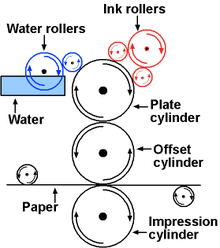 I have over 13 years experience working on various printing presses. I have worked on presses of all various sizes, makes and models. These printing presses range from a 1 color printing press to a 6 color printing press with an aqueous coater to a 7 color printing press with a perfector and an aqueous coater.
I have over 13 years experience working on various printing presses. I have worked on presses of all various sizes, makes and models. These printing presses range from a 1 color printing press to a 6 color printing press with an aqueous coater to a 7 color printing press with a perfector and an aqueous coater.
There are various processes to a printing job. Some of them include sheet wise, work and turn, work and tumble, and one sided jobs. Basically all the previous terms refer to what you do to the sheet of paper after the first pass of printing has occurred. All can have various combinations of colors on each site.
Below is the definition of the printing press and a little history.
A printing press is a device for evenly printing ink onto a print medium (substrate) such as paper or cloth. The device applies pressure to a print medium that rests on an inked surface made of movable type, thereby transferring the ink. Typically used for texts, the invention and spread of the printing press are widely regarded as among the most influential events in the second millennium[1] revolutionizing the way people conceive and describe the world they live in, and ushering in the period of modernity.[2]
The world’s first movable type printing technology was invented and developed in China by the Han Chinese printer Bi Sheng between the years 1041 and 1048. In Korea, the movable metal type printing technique was invented in the early thirteenth century during the Goryeo Dynasty. In the West, the invention of an improved movable type mechanical printing technology in Europe is credited to the German printer Johannes Gutenberg in 1450.[3] The exact date of Gutenberg’s press is debated based on existing screw presses. Gutenberg, a goldsmith by profession, developed a printing system by both adapting existing technologies and making inventions of his own. His newly devised hand mould made possible the rapid creation of metal movable type in large quantities. The printing press displaced earlier methods of printing and led to the first assembly line-style mass production of books.[4] A single Renaissance printing press could produce 3,600 pages per workday,[5] compared to about 2,000 by typographic block-printing[6] and a few by hand-copying.[7] Books of bestselling authors such as Luther and Erasmus were sold by the hundreds of thousands in their lifetime.[8]
Printing soon spread from Mainz, Germany to over two hundred cities in a dozen European countries.[9] However the first book in English was not until 25 years later in 1475. By 1500, printing presses in operation throughout Western Europe had already produced more than twenty million volumes.[9] In the 16th century, with presses spreading further afield, their output rose tenfold to an estimated 150 to 200 million copies.[9] The operation of a press became so synonymous with the enterprise of printing that, by metonymy, it lent its name to a new branch of media, the press.[10] The importance of printing as an emblem of modern achievement and of the ability of so-called Moderns to rival the Ancients, in whose teachings much of Renaissance learning was grounded, was enhanced by the frequent juxtaposition of the recent invention of printing to those of firearms and the nautical compass.[11] In 1620, the English philosopher Francis Bacon indeed wrote that these three inventions “changed the whole face and state of the world”.[12]
In Renaissance Europe, the arrival of mechanical movable type printing introduced the era of mass communication which permanently altered the structure of society. The relatively unrestricted circulation of information and (revolutionary) ideas transcended borders, captured the masses in the Reformation and threatened the power of political and religious authorities; the sharp increase in literacy broke the monopoly of the literate elite on education and learning and bolstered the emerging middle class. Across Europe, the increasing cultural self-awareness of its people led to the rise of proto-nationalism, accelerated by the flowering of the European vernacular languages to the detriment of Latin‘s status as lingua franca.[13] In the 19th century, the replacement of the hand-operated Gutenberg-style press by steam-powered rotary presses allowed printing on an industrial scale,[14] while Western-style printing was adopted all over the world, becoming practically the sole medium for modern bulk printing.
Printing Press. (n.d.). In Wikipedia. Retrieved January 2, 2014, from http://en.wikipedia.org/wiki/Printing_press
Printing Press. (n.d.). In Wikipedia. Retrieved January 2, 2014, from http://en.wikipedia.org/wiki/Offset_printing
Pingback: child porn
Pingback: Bu website sitemap ile güçlendirilmiştir
Pingback: buy naltrexone
Pingback: revatio vs viagra
Pingback: grandpashabet
Pingback: Imulast
Pingback: grandpashabet
Pingback: vilitra 20 side effects
Pingback: grandpashabet
Pingback: Can too many antibiotics cause harm plaquenil dosage?
Pingback: child porn
Pingback: grandpashabet
Pingback: child porn
Pingback: casino porn
Pingback: grandpashabet
Pingback: Anonymous
Pingback: Bu web sitesi sitemap tarafından oluşturulmuştur.
Pingback: porn
Pingback: buy vidalista
Pingback: child porn
Pingback: spisok
Pingback: yasam ayavefe
Pingback: child porn
Pingback: cenforce gold
Pingback: porn
Pingback: Buying Generic clomid no prescription
Pingback: child porn
Pingback: gabapentin 300mg
Pingback: porn
Pingback: buy flagyl over the counter
Pingback: buy vardenafil
Pingback: buy flagyl tablets
Pingback: buy ventolinbuy ventolin inhaler
Pingback: vidalista 20 mg
Pingback: child porn
Pingback: animal porn
Pingback: animal porn
Pingback: list
Pingback: oral Cenforce 50mg
Pingback: animal porn
Pingback: vidalista with no prscription
Pingback: vidalista active ingredient
Pingback: ananızın amı sıkılmadınız mı
Pingback: porn
Pingback: vidalista 60 usa
Pingback: Can you get Generic clomid
Pingback: Where Buy Cheap clomid pill
Pingback: clomiphene for men